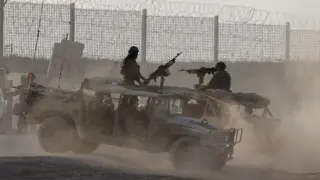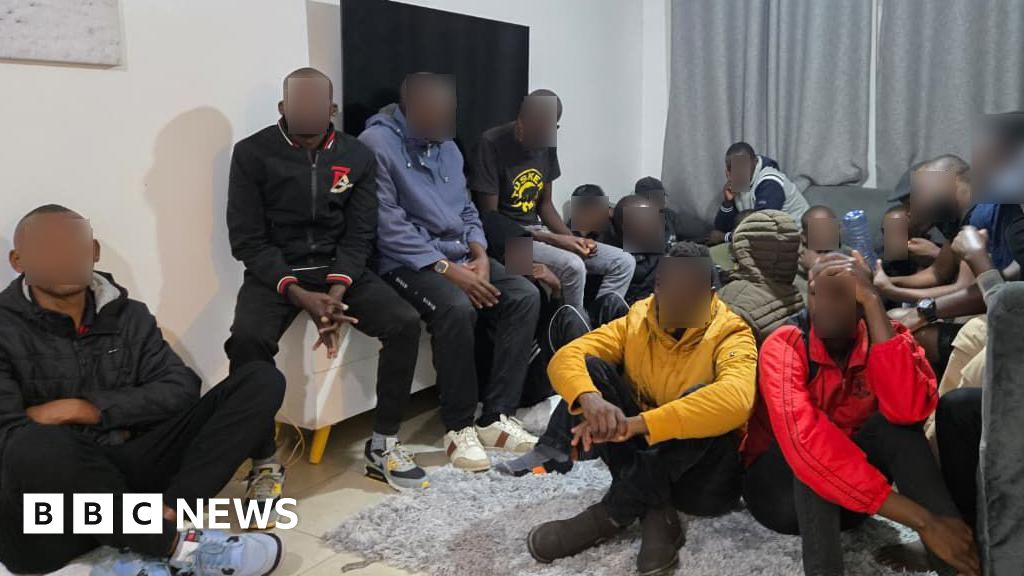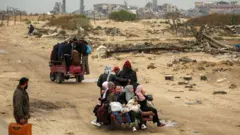BBC News
Thousands of residents have fled Gaza City’s southern Zeitoun neighbourhood, where days of continuous Israeli bombardment have created a “catastrophic” situation, the city’s Hamas-run municipality has told the BBC.
At least 40 people were killed by Israeli attacks across the territory on Saturday, Gaza’s civil defence agency said.
The Israeli military said it would begin allowing tents to be brought into Gaza by aid agencies again. Israel plans to forcibly displace a million people from Gaza City to camps in the south.
In Israel, a one-day general strike is under way in protest of the government’s plan to seize Gaza City.
The stoppage was demanded by the families of hostages and others who say the expansion of the war puts the lives of Israelis being held by Hamas at greater risk.
It comes a week after Israel’s war cabinet voted to occupy Gaza City, the territory’s largest city, and displace its population, in a move condemned by the UN Security Council.
“As part of the preparations to move the population from combat zones to the southern Gaza Strip for their protection, the supply of tents and shelter equipment to Gaza will resume,” the Israeli military body Cogat said.
A spokesperson for the Gaza City municipality said mass displacement was already taking place in Zeitoun after six days of relentless Israeli air strikes, shelling and demolition operations.
The Zeitoun neighbourhood is home to about 50,000 people, most of whom have little to no access to food and water, according to the civil defence agency.
Ghassan Kashko, 40, who is sheltering with his family at a school building in the neighbourhood, told news agency AFP that air strikes and tank shelling were causing “explosions… that don’t stop”.
“We don’t know the taste of sleep,” he said.
Hamas said in a statement that Israeli forces had been carrying out a “sustained offensive in the eastern and southern neighbourhoods of Gaza City, particularly in Zeitoun”.
The Israeli government has not provided an exact timetable of when its forces would enter Gaza City. Israeli Prime Minister Benjamin Netanyahu is reported to want the entire city under Israeli occupation from 7 October.
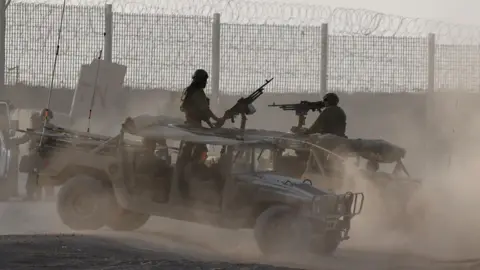 Reuters
ReutersThe municipality spokesperson said that 80% of Gaza City’s infrastructure had been damaged over nearly two years of Israeli attacks, while the four remaining hospitals there were operating at less than 20% of their capacity due to severe shortages of medicines and supplies.
At least 1.9 million people in Gaza – or about 90% of the population – have been displaced, according to the UN.
The international body has indicated there is widespread malnutrition in Gaza, with experts backed by the organisation warning last month in a report that the “worst-case scenario” of famine is playing out in Gaza.
On Saturday, Gaza’s hospitals reported 11 more deaths from malnutrition, including a child, bringing the total number of deaths from malnutrition to 251, including 108 children, according to the Hamas-run health ministry.
Meanwhile, a Gazan woman who was evacuated to Italy for treatment while severely emaciated has died in hospital. The 20-year-old, who was identified as Marah Abu Zuhri, flew to Pisa with her mother on an overnight flight on Wednesday under a scheme established by the Italian government.
The University Hospital of Pisa said that she suffered a cardiac arrest and died on Friday, less than 48 hours after arriving. The hospital said she had suffered severe loss of weight and muscle, while Italian news agencies reported she was suffering from severe malnutrition.
Earlier this week, the UK, EU, Australia, Canada and Japan issued a statement saying “famine is unfolding in front of our eyes” and urged action to “reverse starvation”.
Last week, more than 100 organisations signed a letter that said they had been unable to to deliver a single truck of humanitarian supplies to Gaza since 2 March.
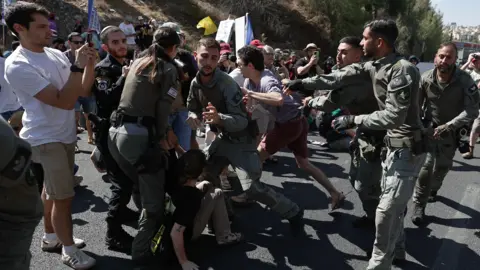 EPA
EPAIsrael has drastically curtailed the amount of aid it allows into Gaza and continues to insist there is no starvation there. It accuses UN agencies of not picking up aid at the borders and delivering it.
The civil defence agency said at least 13 of the Palestinians killed on Saturday were shot by Israeli troops as they waited for food near distribution sites in the territory. The latest figures from the UN, released on Friday, indicate that at least 1,760 Palestinians have been killed seeking food since late May, mostly by Israeli forces.
In Israel, thousands have taken to the streets in a nationwide protest demanding a deal to secure the release of hostages in Gaza. Major roads are blocked and train services have been disrupted.
In Jerusalem and Tel Aviv, many businesses were shut.
“I think it’s time to end the war. It’s time to release all of the hostages. And it’s time to help Israel recover and move towards a more stable Middle East,” Doron Wilfand, a 54-year-old tour guide, told news agency AFP at a rally in Jerusalem.
The war was triggered by Hamas’s 7 October 2023 attack on Israel, which killed about 1,200 people and saw 251 others taken hostage.
Israel’s offensive has killed more than 61,000 Palestinians, according to figures from the Hamas-run Gaza health ministry, which the UN considers reliable.
